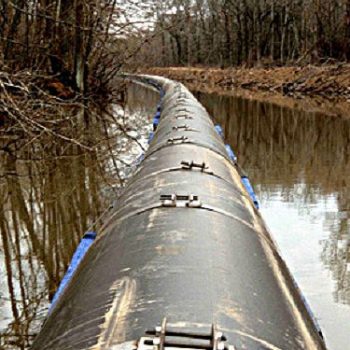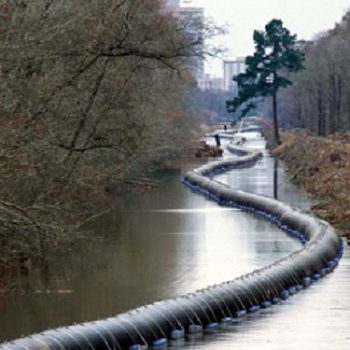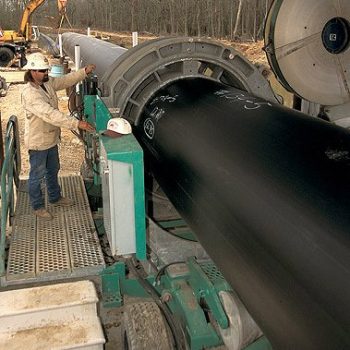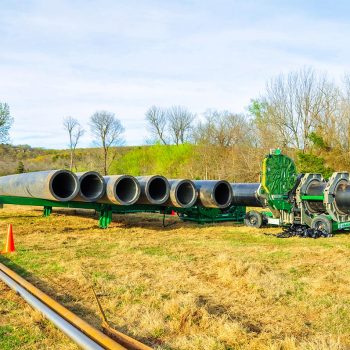Beaumont, Texas — The city of Beaumont Texas was recently faced with the problem of preventing contamination of their raw water source while at the same time protecting the delicate environment of the wetlands that surround their water canal. City officials put on their creative, problem-solving hats and embraced offshore techniques to accomplish both objectives. The innovative operation is drawing attention from other parts of the country that have similar problems.
Beaumont draws its raw water from the Neches River and transports it in a canal system to their treatment facility. The canal system was developed many years ago and the levees that protect the canal from infiltration have eroded making intrusion from outside sources a problem. Of the many non-toxic contaminants, the largest concern comes from the runoff of wetlands along with saltwater contamination during the hurricane season. By eliminating these impurities the treatment plant will not only function more efficiently, it will also dramatically lower its operating cost.
The main problem the city faced was trying to perform construction operations in federally protected wetlands. The remediation process can take months and the expense can be staggering. The levees cannot simply be built back up because for every acre of wetlands that is disturbed, seven other acres of land must be turned into wetlands.
Polyethylene is the only piping material that could have been used for this job
The city’s water supply is taken from the Neches River above a dam that is being constructed that will act as a salt-water barrier. The dam will be equipped with gates that can be shut when a tidal surge situation occurs. During a tidal surge salt water drifts up the Neches River and the raw water harvested by the city is brackish. The canal runs parallel to the river for about 12 miles and then travels through a pipeline under the river to a pump station. From the pump station the water travels 13,000-feet down the canal that has the problem of eroded levees.
The decision was made to install a 48″ HDPE DR 32.5 pipe and pump the raw water the last 13,000 from the pump station to the plant. The old canal system would provide the path the pipe will take so that there would be no digging required and the wetlands would not be disturbed.
“Polyethylene is the only piping material that could have been used for this job,” said Everett Phelps, Consultant for Brystar Contracting in Beaumont. Brystar is the contractor for the project and known throughout Texas for performing unique jobs using PE.
Four years earlier Brystar came to the rescue of the town of Edgewood, TX when the city ran out of water due to their reservoir drying up. The city was forced to ship bottled water in for their citizens. Brystar installed 11 miles of 10″ HDPE in a total of 17 days and began pumping water from a nearby lake into Edgewood’s empty reservoir. The event made headlines nationally.
For the Beaumont canal job, Brystar set up a staging area in a park that is located at the Neches River crossing. They purchased approximately 13000′ of 48″ SDR-32.5 Rinker Materials Polypipe from Maskell-Robbins Inc. (a distributor for Polypipe). The pipe sections were stacked and after the pipeline is completely fused together it will be connected to the pump at this location.
Brystar rented a massive McElroy 2065 from Maskell-Robbins Inc. (a distributor for McElroy equipment also) to fuse the pipe together. They constructed a shed to house the McElroy 2065 Fusion machine in order to protect the fusion joint while it is being performed in the event that it rains heavily.
Butt fusion is the process of using heat and pressure to connect polyethylene pipe end to end. The ends of the pipe are melted with a heater and after it has become molten, the pipe ends are pressed together and held until the melt cools. The resulting joint is stronger than the pipe so there is no need to reinforce the joint.
“McElroy fusion machines are the only fusion equipment we have ever used,” said Phelps. “McElroy has had the joint integrity perfected for a long time but PE has had to overcome a lot of stumbling blocks as far as tie-ins are concerned. Now there are all the fittings you could ever need for any piping system.”
As the pipe is being fused together, 2000-pound concrete weights are attached to the pipe at eight-foot intervals before it is pushed out into the canal. The pipe is capped on the end so it floats in the water as it is being fed, one section at a time, into the canal toward the treatment plant. When all 13,000-feet of pipeline is completed, the cap will be removed, the pipe will fill with water and sink to the bottom of the 20-foot deep canal.
“The canal made the process simple because we could operate the fusion machine from one location,” said Phelps. “We didn’t have to worry about clearing a right of way for the pipe or digging a trench or boring it in. We simply pushed it down the canal.”
The canal has been dredged to grade and after it is in place, a scuba diver will inspect the line to make sure it is resting on the bottom properly.
The technique for sinking the pipeline was developed for offshore pipeline construction. It has been used a few times for long fresh water crossings in the U.S.
PE has been the standard pipe for the gas industry in the U.S. for about thirty years and is finally taking a foothold in the water market. Reports from the U.S. Environmental Protection Agency estimate a need of $138 billion for water infrastructure repairs, just to meet regulations. Since PE does not rust, corrode or leak at the joints, many experts feel that PE is the best material to solve the U.S. infrastructure problems.
“A lot of people have lobbied to try to keep HDPE out of the mainstream of water pipeline construction but it is unquestionably the pipe of the future,” said Phelps.
PE’s largest problem seems to be the inability of its own lobbyist to structure a well-organized plan to educate decision makers of the advantages associated with PE. Many point to the success that Europe has had in upgrading their water systems with PE, but have failed to present research of positive results to key decision makers.
The most significant advance of PE for water in the U.S. has been the direct result of developments in trenchless construction technologies. PE is also the preferred material for many applications including slip-lining, pipe-bursting, horizontal directional drilling, direct burial, water crossings, intake & outfall pipelines and firewater systems.
Firewater systems is the more recent success story advancing the use of HDPE as the main piping material for Firewater service in power plant construction.




